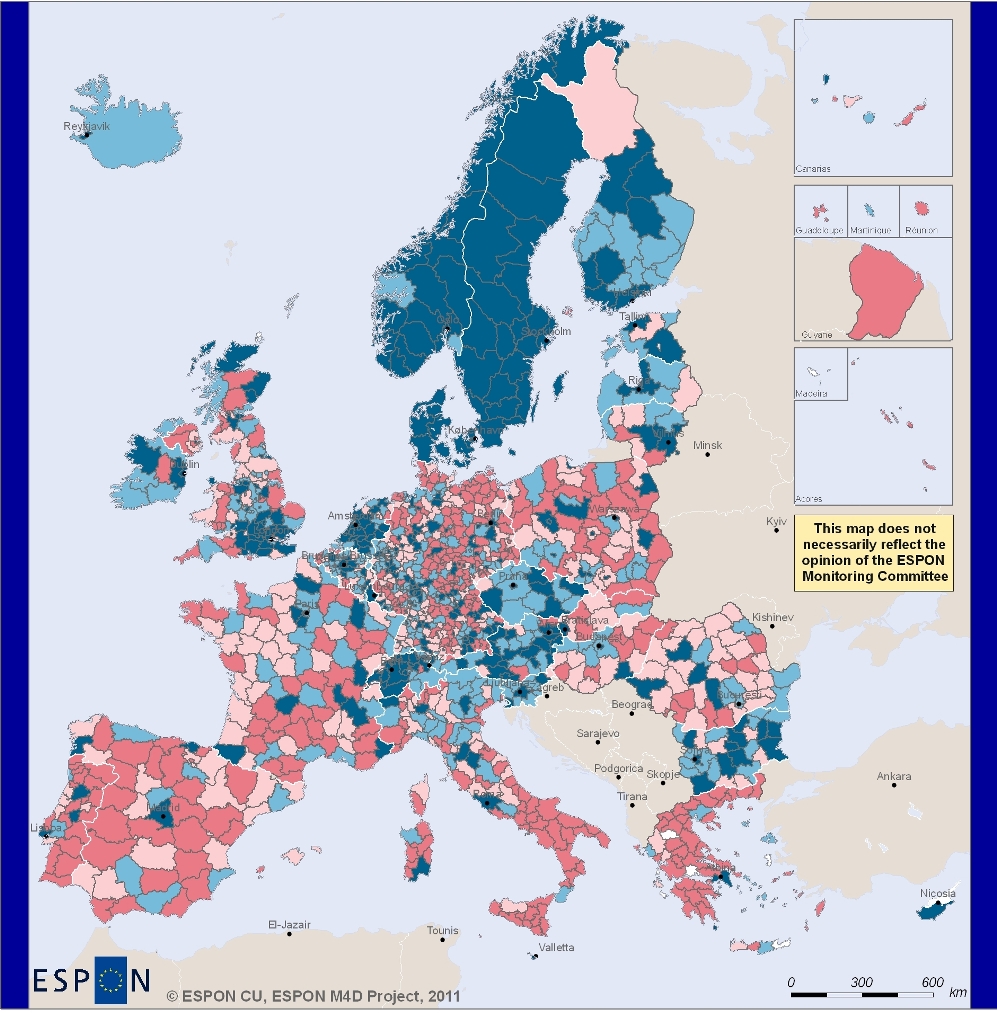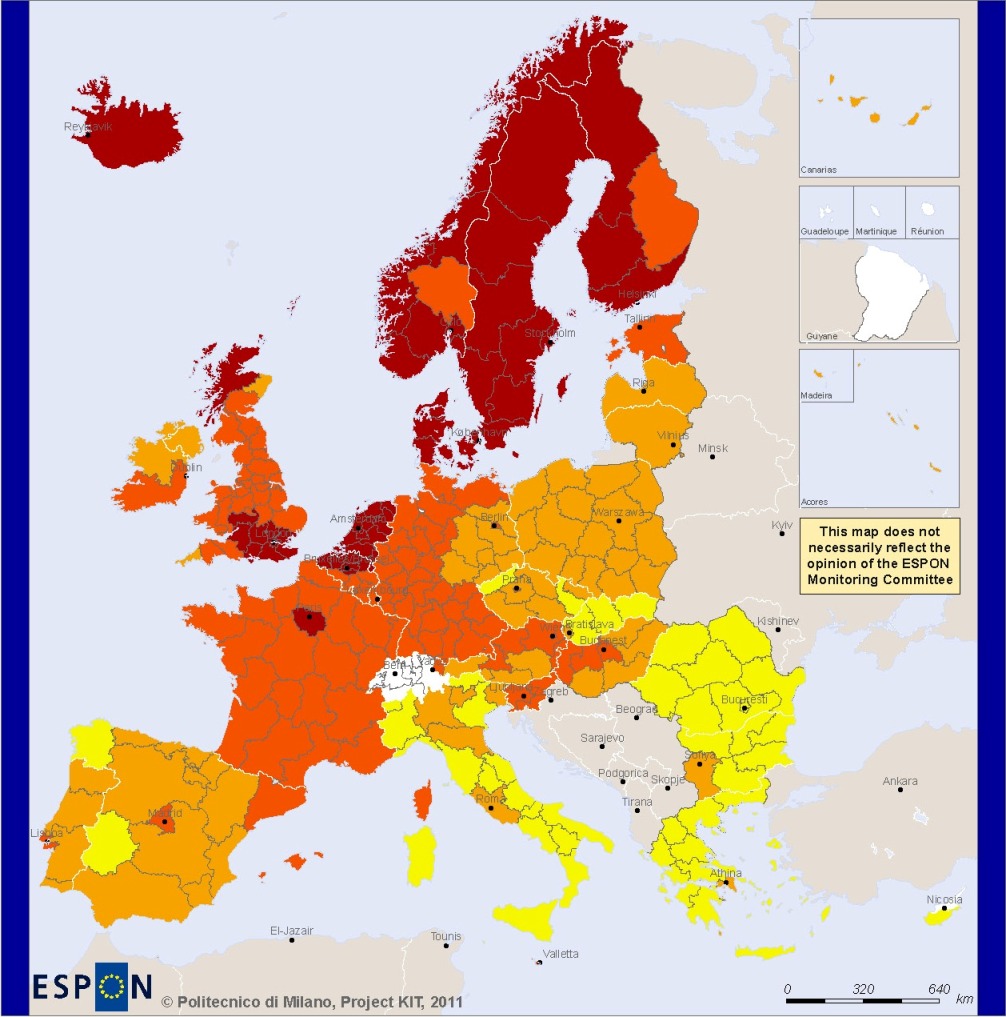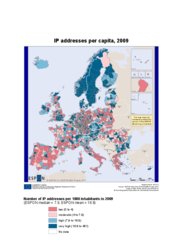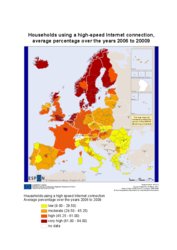Internet Roll-Out in the EU Regions
IP Addresses per capita (left image);
High-Speed Internet Connection (right image)
Internet Infrastructure and Usage in the EU regions
May 2011 - EU Cohesion Policy contributes to the Europe 2020 Strategy and the Territorial Agenda. Investments in regions and cities all over Europe shall support and stimulate an intelligent, sustainable and inclusive growth of the Union. The ambition is to ensure and enhance European competitiveness in a rapidly changing and connecting world.
The Europe 2020 Strategy identifies extensive use of information and communication technologies as a necessity for growth. Europe is seen as not progressing fast enough in comparison to the rest of the world. A precondition for smart growth is therefore that Europe acts in accordance with the development of a digital society.
This is outlined in the Europe 2020 flagship initiative “A digital agenda for Europe”. The aim of this initiative is to create a single digital market based on fast and ultrafast Internet and interoperable applications. The goal for 2013 is to ensure that all European households have access to high-speed Internet, which by 2020 will offer the highest possible speed to 50% of the households.
The Territorial Agenda for the European Union specifically addresses the importance of securing access to infrastructure facilities. The territorial distribution of Internet infrastructure is important for promoting a polycentric and balanced European territory where all regions and cities are connected to the global flow of information and activities.
Concept / method / measurement
One way to measure the development of the Internet infrastructure is the number of IP-addresses. Every computer connected to the Internet has a unique identifying number, called an IP address (Internet Protocol address), and if a country, region or city has a high number of IP addresses, this means that this territory has a high number of computers actively connected to the Internet.
The data for the indicator ‘number of IP addresses’ has been derived from the DIMES project from Tel Aviv University by using Internet measures, such as trace route and ping, from which the geography of IP addresses could be retrieved. In terms of the calculation of the number of IP addresses, the data was initially provided at city level. Therefore an aggregation took place at the level of NUTS3 regions. In addition, the data, being available for weekly intervals, was aggregated to the annual sum for each region leading to the actual number if IP addresses. Finally the data was divided by the total population.
One way to measure Internet usage and thereby the progress of the goal of the “digital agenda for Europe” to provide high-speed Internet access for all by 2013 is the indicator ‘households using a high-speed Internet connection’. The territorial distribution of this measurement captures the diffusion of an advanced Internet technology in everyday life and provides an interesting perspective on the distribution of a new technology.
Data for the percentage of households using high-speed internet connection are collected in yearly surveys administered by EUROSTAT. High-speed Internet connections are defined here as Internet connections with a capacity equal to or higher than 144 Kbits/s. However, for each of the years between 2006 and 2009 data gaps exist. The map therefore presents a four year average of the 2006 to 2009 surveys. Moreover, in some countries, namely France, Poland and Germany, data are collected at NUTS1 level.
Observations
The map on ‘IP addresses per capita’ reveals the regional geography of Internet infrastructure in Europe, showing the relative number of IP addresses in European regions (at NUTS3 level) in 2009.
Not surprisingly the regions with the highest concentration of IP addresses in 2009 are the main metropolitan regions and capital cities of Europe. The first group of ‘IP address hotspots’ include cities such as London, Paris, Amsterdam, Stockholm, Milan and Madrid, but also the capital cities in newer EU Member states such as Warsaw, Sofia and Bucharest are among the cities hosting a significant share of Europe’s IP addresses.
Another striking observation is that a large number of regions across the EU territory score a low or moderate number of IP addresses. A closer look reveals that this includes intermediate and peripheral regions as well as remote regions. However, one exception seems to be the Scandinavian countries, where a more territorially balanced pattern is present and low-density populated areas score high numbers of IP addresses per capita, apparently having sufficient Internet infrastructure in place.
The map on ‘households using a high-speed Internet connection’ presents the average percentage of households using a high-speed Internet connection for the years 2006 to 2009. The territorial distribution of this indicator displays evident signs of country effects, naturally introduced by the country-wide Internet infrastructure projects that both public as well as private companies launch and manage. Regions in which high-speed connections show higher penetration rates belong to the Nordic countries and in the Netherlands. Moreover, capital regions show strong performance in this measure of innovation diffusion, compared to other regions of the same country.
South-Eastern regions in Romania, Bulgaria, Greece, Italy, Cyprus and some in Spain present a rather persistent lag when compared to regions in North-West Europe. However, striking evidence occur when comparing Polish and Baltic regions, with relatively lower standards of living, with richer regions such as the Northern Italian. This comparison presents similar rates of high-speed penetration, thus illustrating the case of a non linear relationship of the technology adoption curve as a function of the region’s development stage.
Not surprisingly a high correlation between the two maps can be spotted. The cities mentioned to be ‘IP address hotspots’ also appear as regions with high level of Internet usage due to the fact that people using Internet requires an IP address. However, a high number of IP addresses in a region does not immediately give an indication on how much the Internet is being used in that region. The IP address can be hosted in a different location from the user, for example. Thus, both indicators are important to be considered in relation to Internet roll-out
Conclusions
The main conclusions on the territorial trends of Internet roll-out are included in the following key messages:
- Internet infrastructure in Europe is heavily concentrated in the metropolitan regions, particularly in the Internet diamond consisting of London, Paris, Frankfurt and Amsterdam. At the same time, a number of cities more peripheral to the centre, including Stockholm, Madrid, Milan and Vienna play important specialised gateway roles at regional level.
- The solid position of the largest European cities and the current developments strengthening this position is to be considered positive for the European economy and global competitiveness. A prerequisite for the large cities to play their role as major drivers in the European economy is constant improvements in terms of high-speed Internet infrastructure.
- The city-based Internet facilities are also used by all other regions throughout Europe. The main challenge at regional level concerns the linkages available for local enterprises and citizens to the Internet infrastructure, in particular via high-speed Internet.
- A widespread and rapid increase in Internet usage is occurring across European regions. Europe’s highest levels of Internet usage are found in the Nordic countries, in the Netherlands, Nordrhein-Westfalen, Luxembourg, Southern England and the Highlands and Islands of Scotland.
- A small group of regions in South-Eastern Europe, including regions in Greece, Bulgaria and, particularly Romania, however, seems not to share in the rise in Internet usage, indicating a need for targeted policy measures and additional investments. While most of the remaining parts of Southern and Eastern Europe experience a moderate expansion, the development in Central Europe is somewhat higher.
- Although Northern Europe stands out in relation to Internet usage, more and more regions are being integrated into the digital networks and moving into higher levels of access and usage by its citizens. An interesting feature of this development is the fact that high living standards do not seem to be a prerequisite to take part in this development.
- In terms of Internet usage, the Internet rollout in Europe appears to proceed very favourably both in scope and scale and in relation to the aims of territorial cohesion and a balanced EU territory.
More information
- Further reading: ESPON Territorial Observation No 4.
- The map on ‘IP addresses per capita’ is based on an ‘Update on Map and Related Data on Telecommunication and IT-Rollout’ by E. Tranos, A. Gillespie and R. Richardson, Newcastle University, United Kingdom, February 2011.
- The map on ‘households using a high-speed Internet connection’ is built by the ESPON KIT Project on Territorial Dimension of Innovation and Knowledge Economy. Their Interim Report is available on the ESPON website.
- Expert at the ESPON Coordination Unit: Marjan VAN HERWIJNEN, e-mail: [email protected]





